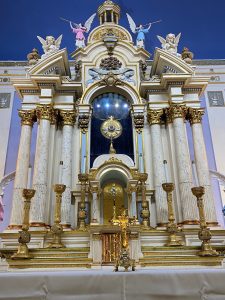While working on the strategic diaconate initiatives project of The 4:12 Pathways for Pastoral Leadership grant, I seized the opportunity to visit the Old Ursuline Convent located in the French Quarter of New Orleans. The Convent is one of the city’s most significant cultural, architectural, and religious gems. Originally designed in 1745 for the Ursuline nuns who came to Louisiana from France in 1727, it was completed in 1752 and is the oldest building in the Mississippi River Valley. The Ursuline nuns remained at this location using their convent as a site to minister to the poor and sick while also providing an orphanage and a school for girls until 1824.
The site then served briefly as a meeting place for the Louisiana legislature and then it became the residence of the archbishops of New Orleans until 1899. In 1848, a section of the Old Ursuline Convent was demolished, and replaced by St. Mary’s Church, which functioned as the chapel for the archbishops. The Convent was later used as an administrative office for the archdiocese and as a seminary. In 1968, the Old Ursuline Convent was awarded the designation as a “Registered National Historic Landmark.”
The magnificent altar, at St. Mary’s Church, visible in the photograph provided a fitting backdrop to begin the strategic diaconate initiatives video series. The short video clips on the diaconate were

St. Mary’s Chapel Altar
filmed on location with Deacon Ray Duplechain, the Director of the Diaconate for the Archdiocese New Orleans. At the center of the altar, the large monstrance, perched above the cross caught my eye. I learned this historic monstrance was designed, crafted, and used for the 1938 Eucharistic Congress.
The stunning monstrance was created through the generous gifts of 5,000 individuals who contributed gold, silver, platinum, and precious stones. Standing tall at 42 inches and weighing 25 pounds, this marvelous artwork was once reserved for special occasions, but in 2002 it was put on permanent display. It is secured in a bulletproof glass case at the top of the altar and is on an elevator which is lowered at night for safekeeping and to facilitate reverent handling of the Blessed Sacrament for exposition. While it may be challenging to fully appreciate its beauty and intricate detail from a distance, its outer ray tells a significant story – depicting the first Eucharistic procession held in New Orleans on July 17, 1743. This historic event saw clergy, religious, government officials, parishioners and children united in a journey alongside the Ursuline nuns, moving their temporary residence to a new convent on this sacred site. Though the new convent, was poorly constructed, King Louis XV recognized its importance and authorized the design and construction of the current structure on the same site, completed in 1752.
During our video shoot that day and in our subsequent interviews, I could not remove thoughts of the significance of the monstrance for the City of New Orleans, for the Church in the United States, for our Universal Church and for the diaconate from my mind. All Christian life is intertwined with the Eucharist; it flows from the Eucharist and is directed toward the Eucharist. For deacons, in particular, our spirituality is nourished by the Eucharist, which, in turn, characterizes the ministry of the deacon as service sacramentalized. Deacons are icons of Christ the Servant, who came to serve not to be served.
At the end of Mass, having consumed the body and blood of Christ, each of us is called to become what we eat. Christ for each other. Christ serving Christ. It is the deacon through the dismissal at the end of Mass, “Ite Missa Est,” meaning “Go Forth the Mass Has Ended” —who then leads the assembly out of the Church. We, the Body of Christ, become a living Eucharist procession, bringing Christ out into the world with our deeds and actions. The monstrance was a magnificent reminder of who we are called to be as deacons and as Christians.


0 Comments